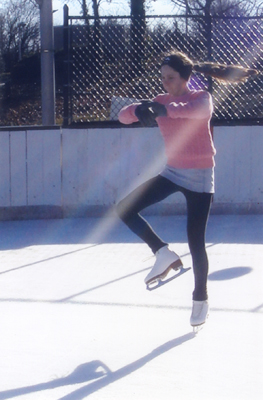All Nonfiction
- Bullying
- Books
- Academic
- Author Interviews
- Celebrity interviews
- College Articles
- College Essays
- Educator of the Year
- Heroes
- Interviews
- Memoir
- Personal Experience
- Sports
- Travel & Culture
All Opinions
- Bullying
- Current Events / Politics
- Discrimination
- Drugs / Alcohol / Smoking
- Entertainment / Celebrities
- Environment
- Love / Relationships
- Movies / Music / TV
- Pop Culture / Trends
- School / College
- Social Issues / Civics
- Spirituality / Religion
- Sports / Hobbies
All Hot Topics
- Bullying
- Community Service
- Environment
- Health
- Letters to the Editor
- Pride & Prejudice
- What Matters
- Back
Summer Guide
- Program Links
- Program Reviews
- Back
College Guide
- College Links
- College Reviews
- College Essays
- College Articles
- Back
One Rink with Two Purposes
Winter is coming up soon, and you know what that means--snow and cold weather! On a frozen pond or skating rink, a single blade cuts across the surface of the ice, with the potential to become one of two very different sports. It can transform into the grace and beauty of figure skating or the strength and teamwork required for hockey. With one rink transpiring into either a field for ice hockey or the dance floor for a figure skater, there's no question that the ice is their common ground. Yet there is so much that sets each sport apart, such as the equipment needed, the sport itself, and the training necessary to perform the sport. However, being an ice skater myself and an observer of basic hockey training, I can truly say I prefer figure skating to ice hockey because of these differences.
The first difference is in the equipment. Figure skaters and hockey players both wear ice skates, but the similarities end there. Figure skates have toepicks (small pieces on the tip of the blade that allow skaters to jump and stop more easily), the blades are made for spins and jumps, and the skates are made of leather with a heel that is usually wood; whereas hockey skates do not have a toepick, the blades are designed to handle turning, stopping, and fast skating, and the skates are typically made of plastic with no heel. Another distinction with the equipment is what each sport has to wear. For hockey players, it is required to have the following: helmets and face masks/shields, shoulder pads, chest protectors, gloves, elbow pads, leg guards, a hockey stick, and hockey skates! However, a figure skater only needs comfortable, tigh fitting clothing for practice, and a costume for competition which includes special tights, plus their figure skates. Figure skating and hockey both have clear differences in the equipment needed, but that is not the only difference between these two sports.
The next distinction is how each sport is performed or played. Ice skating involves a single skater, with the exception of pairs or sychronized skating, who learns to essentially "dance on ice." For competitions, routines are created and performed in front of judges and an audience. Hockey is played with a set of teammates and is all about teamwork. The purpose is to play offense and defense while utilizing sticks to get the puck into the opposing team's hockey net and to stop the opposing team from scoring a goal. A referee keeps the game fair for hockey, while in figure skating, a board of judges determines the skater's score.
However, the most important difference of all is training. Both sports get their start in basic lessons where one can learn to skate, stop, and fall the proper way. Once the basics are mastered, then the differences between the skills needed for each sport becomes more obvious. Soon after, the two part ways. Figure skaters learn spins, jumps, and special footwork to perform their moves. Often, to augment what they learn on the ice, a figure skater may choose to study ballet or another form of dance as well. Hockey, on the other hand, focuses on weight lifting for strength, field training for better technique and different strategies, as well as footwork for quick stops, turns, and maneuvers on the ice. Of course, as with any sport, the proper nutrition and excercise is imperative if one wishes to be serious about either sport.
Both hockey and ice skating take skill and determination, however the two are far from the same. As I've showed you, the differences are huge--from the equipment, to the skills, to the training. Yet they still will both share the ice, the rink, and the need for skates. At the end of the day, no matter how different figure skating and hockey may be, one thing remains true of both: the love of the ice, the feeling of the crisp air rushing past, and the talent it takes to suceed is something that both hockey players and figure skaters can agree upon. Once a skater, always a skater.

Similar Articles
JOIN THE DISCUSSION
This article has 0 comments.
